by Editor | Oct 30, 2017 | Luxury Travel, Products
Article and photos by Aaron Lubarksy
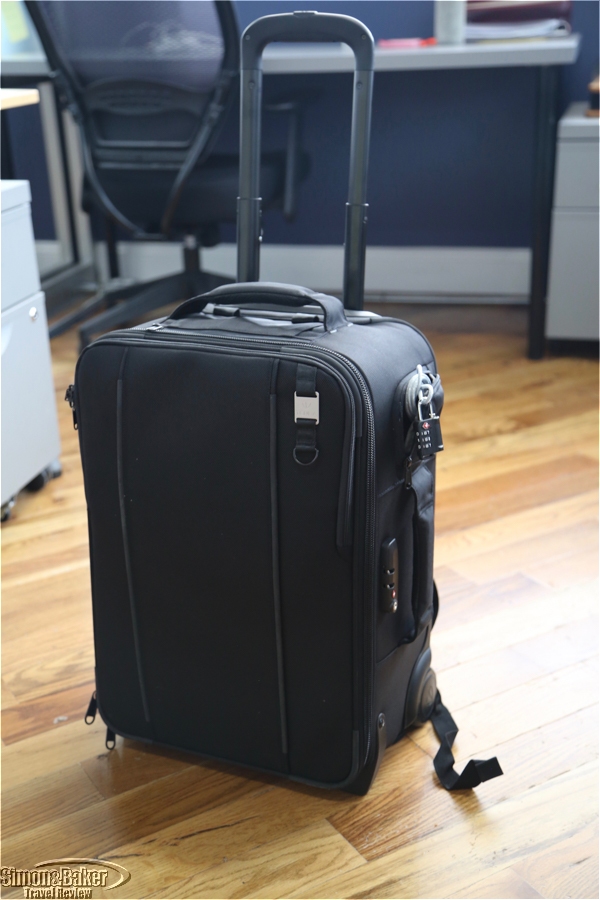
The Tenba 21 Hybrid Roller
I really wanted to love the Tenba 21 Hybrid Roller (Tenba, 75 Virginia Road, North White Plains, New York 10603, +1 914 347 3300, www.tenba.com, info@tenba.com). On paper it’s the perfect camera bag: a solid, versatile, roller bag that I can also throw on my back. On the road its performance was mixed. It was a terrific bag with a couple of small but maddening flaws that drove me a little nuts on a recent shoot.
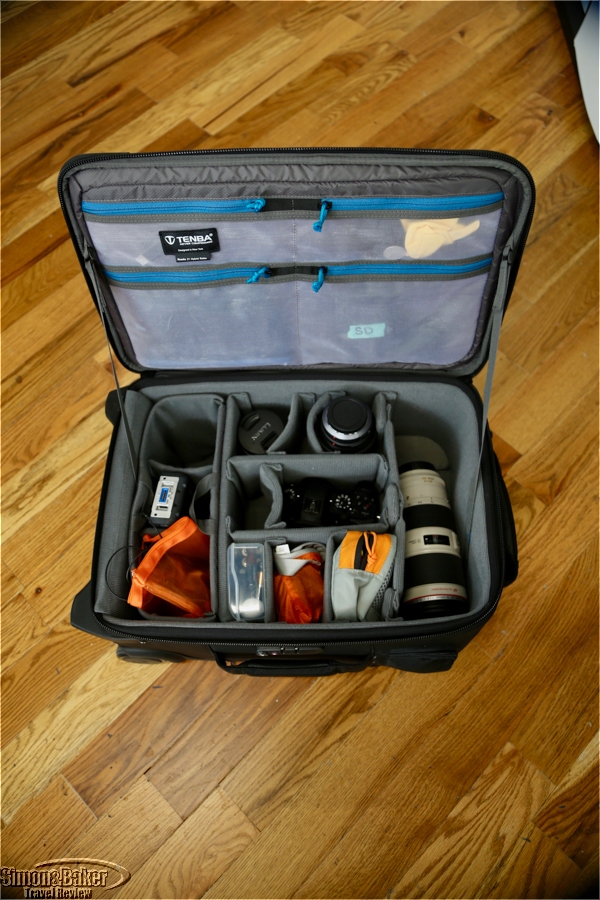
The Hybrid Roller offered a generous amount of storage space.
The Hybrid Roller, made in China, offered a generous amount of storage space, flexibility, and elegance. It had plenty of zippers and inner pockets, including a removable padded camera insert. It comfortably held everything I needed for a recent DSLR shoot, including my sound gear and a laptop. The interior dimensions of the bag were 12 wide by 17 tall by 7 deep, in inches. It had a handy drop-in tripod carrier which was a nice (and space-efficient) touch. If I wanted security, this bag had me covered with two built in locking mechanisms: a steel security cable and lock plus an integrated TSA (Transportation and Security Administration) approved zipper lock. Like other Tenba bags I have used, the roadie 21 was durable, weather resistant and a cut-above the competition in terms of luxury and style. I liked it for carry-on luggage.

The Hybrid Roller single exterior pocket
As someone who likes to keep things organized I love pockets and compartments, so a minor gripe I had with this bag was the lack of an easily accessible exterior pockets (for a boarding pass, water bottle, kindle, snack, chargers). The Hybrid Roller only had only one exterior pocket, which made the bag look sleek and discrete, but limited its practicality for travel. While the exterior could have used more pockets, the interior delivered on that front and provided a safe home to my gear.
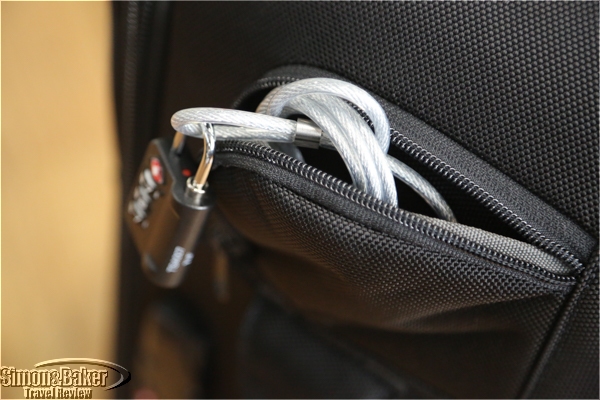
The built-in steel security cable and lock
However, the backpack part just didn’t cut it for me. The bag lacked the kind of padding and contours that are a natural feature in most bags designed to be backpacks I have used. When on my back it was uncomfortable and rigid, the straps felt thin, and the bag felt heavy and bulky (it weighed 11 pounds empty). It was my primary bag on a recent three day travel shoot from New York City to Utah and Idaho. By day two I was only using it as a roller bag.

The integrated TSA approved zipper lock
I was hoping as a hybrid I could easily switch from backpack to roller bag, but when I had the backpack area opened, the straps would get caught in the wheels, ruining my flow (and the straps). Bottom line: to use it as a roller bag, I needed to first put away the backpack set-up (or cut the straps). For my colleagues who want a hybrid bag, and have the patience to withstand some discomfort and set-up, this bag packed a punch, but I recommend committing to the roadie 21 roller bag, not the hybrid version.
by Editor | Aug 14, 2017 | Accomodations, Ecotourism, Luxury Travel
By Elena del Valle
Photos by Gary Cox
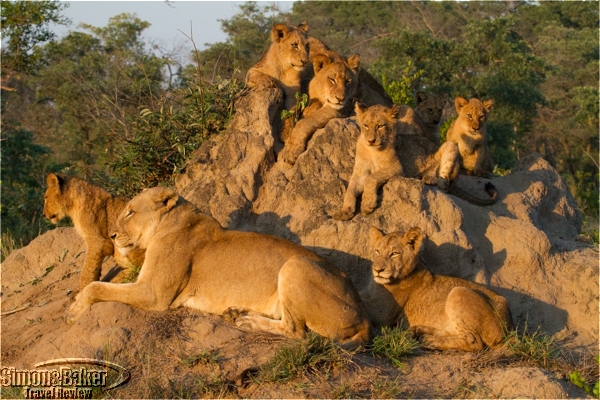
Watching the sun come up with the Southern Pride was one of the highlights of our trip.
On a recent safari trip to South Africa we stayed at Sabi Sabi Earth Lodge and Sabi Sabi Bush Lodge (Sabi Sabi Private Game Reserve, Sabi Sand Wildtuin, Mpumalanga, South Africa, lodge +27 13 7355-656, Sabi Sabi head office +27 11 447-7172, www.sabisabi.com, res@sabisabi.com). The two five star properties, members of the National Geographic Unique Lodges of the World, were family owned and located within the 6,000 hectare Sabi Sabi Private Game Reserve, which is within the Sabi Sand Reserve. It in turn is a Big Five reserve adjacent (without fences) to the famous Kruger National Park. At Bush Lodge we stayed in comfortable and spacious rooms, and we especially enjoyed the game viewing in a private vehicle and spa massage.
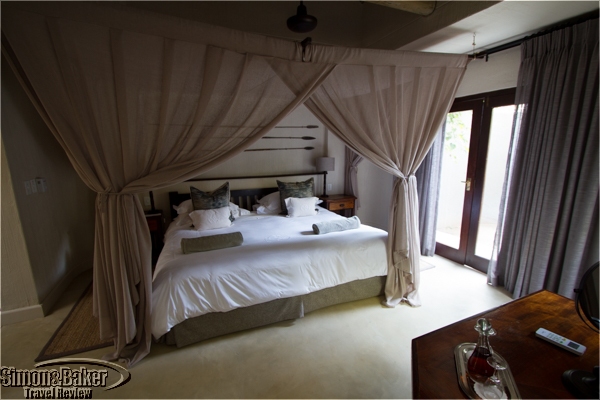
Our beds had color coordinated mosquito netting, a change from the customary white netting
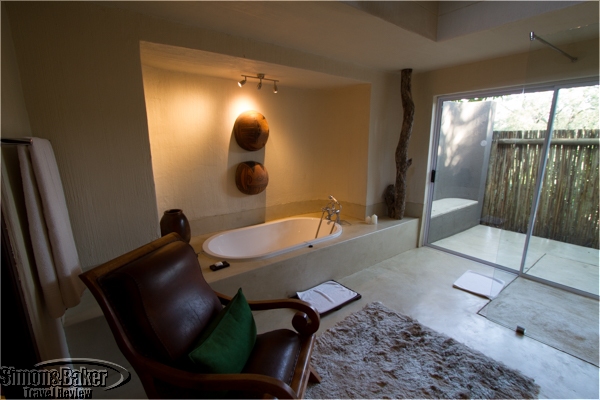
Our spacious bathrooms had a bathtub as well as indoor and outdoor showers.
During our visit, Stefan Schoeman, general manager lodges, Sabi Sabi, assisted us with camera related issues with speed and ease. We were glad to have our cameras in good working order since we saw the Big Five at Bush Lodge. On our first of two game drives we saw four of the Big Five. We drove around in an open Toyota LandCruiser in search of wildlife and interesting natural features to observe. We were delighted to have the game vehicle and Francois Rosslee, ranger, and Dollen Nkosi, tracker, to our selves. We have found that private game drives enhance our bush experience. So it was at Bush Lodge. Francois, a friendly man fond of his job, had been our ranger at Earth Lodge, where we had shared the vehicle with two other guests. That facilitated our arrival and check-in at its sister lodge.
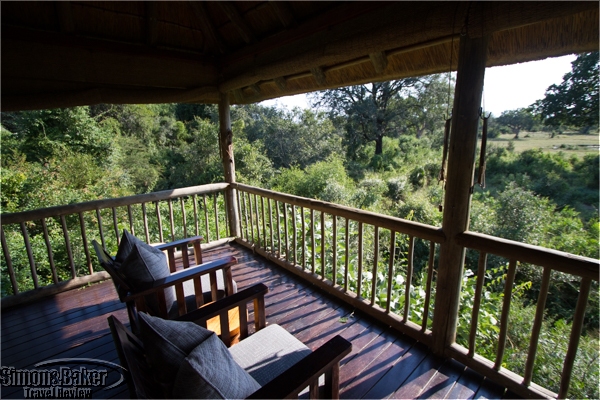
The main deck had several lookout points over the dry river
Francois was a Full Trails Guide Level 2 of the Field Guides Association of Southern Africa (FGASA) with six years of experience and a seemingly inexhaustible supply of energy. Dollen had attained a FGASA Tracker Level 2 and had been with Sabi Sabi for nine years.
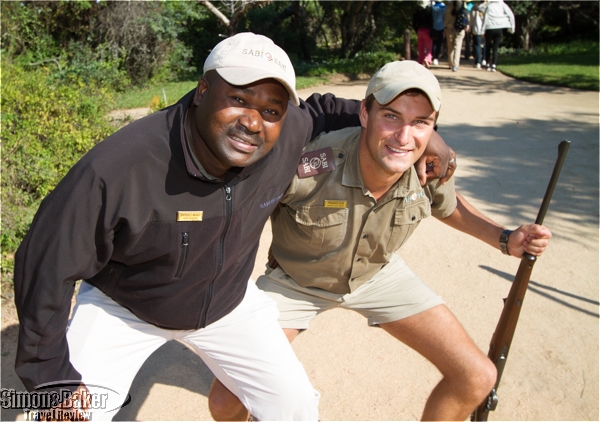
Our ranger Francois Rosslee (right) horsing around with Lawrence Mkansi, assistant lodge manager and head ranger
At Bush Lodge we saw the following mammals: buffalo, common duiker, dwarf mongoose, elephants, hippopotamus, kudu, leopard, lion, scrub hare, side-striped jackal, spotted hyena, tree squirrel, vervet monkey, warthog, waterbuck, white rhinoceros; insects: African monarch butterfly, Broad-bordered grass yellow, blue pansy, scarlet tip; trees and shrubs: jackalberry, knobthorn, leadwood, buffalo-thorn, silver cluster-leaf, large-leaved rock fig, greenthorn, and tamboti; and plants: wild cucumber, fannel weed, feather-top chloris, herringbone, and thatching yellow.
We saw or heard the following bird: African fish eagle, African grey hornbill, African scops-owl, bateleur eagle, Burchell’s starling, Cape glossy starling, Cape turtle dove, crested barbet, crested francolin, dark-capped bulbul, emerald-spotted wood-dove, fork-tailed drongo, go-away-bird, greater blue-eared glossy starling, green woodhoopoe, magpie shrike, rattling cisticola, redbilled oxpecker, southern yellow-billed hornbill, spotted thick-knee, Swainson’s spurfowl, laughing dove, Flappet lark.
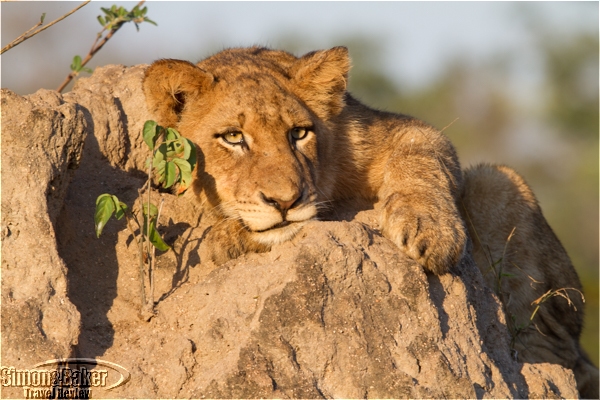
One of the lions
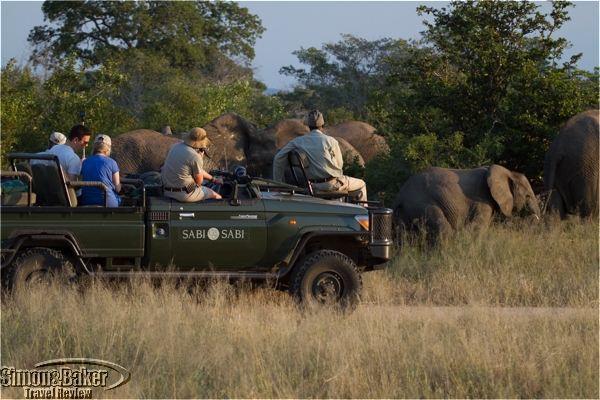
Approaching a sighting in progress
The 25 room family friendly property owned by Hilton and Jacqui Loon had two swimming pools, an amply stocked boutique shop (branded clothing, jewelry, coffee table books, art, accessories), Amani Health Spa, and EleFun Children’s Centre. Although the game reserve and lodge opened in 1979, during 2015 and 2016 the public areas and rooms were completely refurbished.

Our rooms had a sitting area, desk and small outdoor patio facing the dry riverbed.
Our 80 square meter well appointed Luxury Suites faced a dry riverbed. They were comfortably furnished (I especially appreciated the large pleasantly firm bed), quiet, cool when it was hot outside and warm when it was cold. Like its sister property it had a number of amenities such as coffee machine, mini refrigerator and perfume scented Charlotte Rhys toiletries as well as thoughtful touches like a convenient location for electric plugs on the desk and pre-stamped postcards.
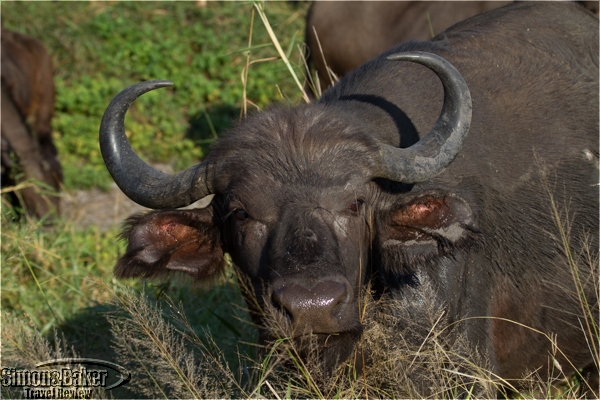
We had excellent closeup sightings of Cape buffalo, one of the Big Five.
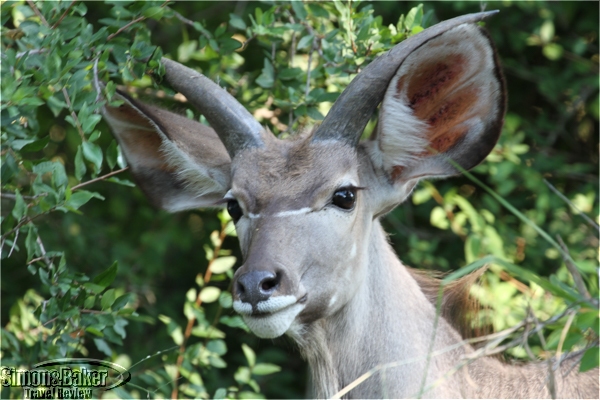
A young kudu male with horns just developing
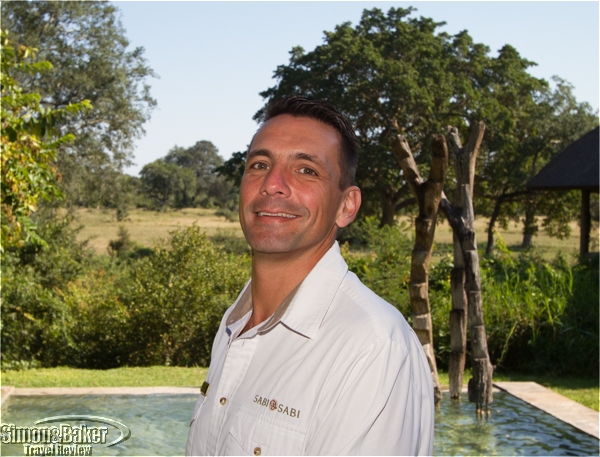
Stefan Schoeman, general manager, was a gracious host.
Meals were buffet style, with a made to order station, in an open air dining room in the main area. We sat at the table of our choice, where staff took our beverage orders. We enjoyed a delicious dinner, including Lamb neck, grilled meat and venison (gemsbock) in the boma (African open air enclosure).
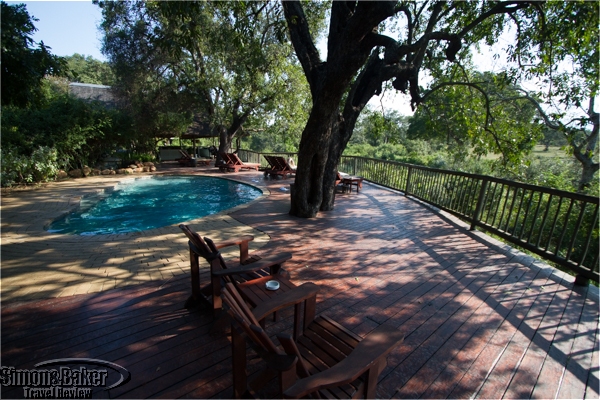
The pool deck had a view of the river

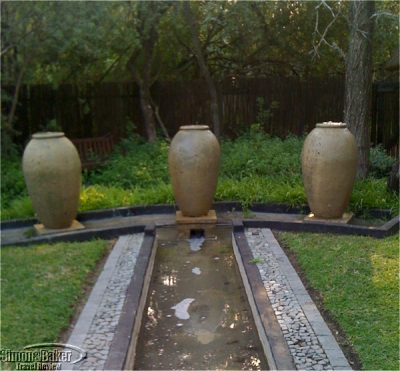
One of my favorite activities was a massage treatment with Tarren, the spa manager and Francois’s girlfriend. Had there been more time I would have explored the spa menu further. The excellent Big Five game viewing and spa treatment made our stay at Bush Lodge special. I would return and recommend it to friends seeking a family and group friendly stay in the Sabi Sand Reserve.
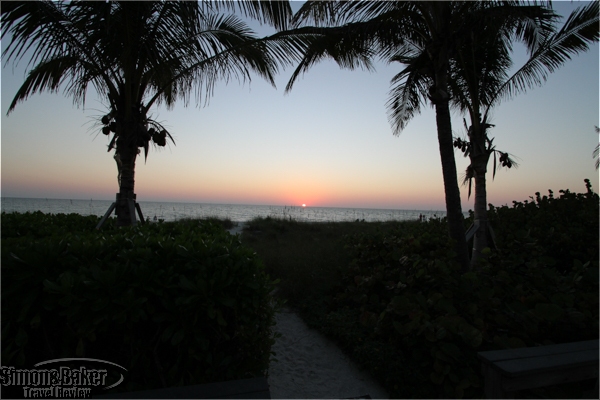
by Editor | Jun 19, 2017 | Attractions, Luxury Travel
By Elena del Valle
Photos by Gary Cox
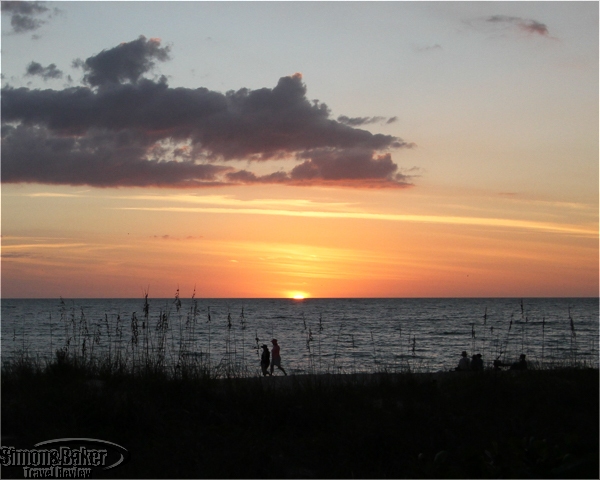
Sunset over the gulf on Anna Maria Island
For some reason I had it in my mind that Anna Maria Island, an island with three distinct municipalities off the coast of Bradenton, Florida, would be a sleepy relaxed vacation place. Sleepy it was not. We visited during the low season and it was bustling with people (and some pets), especially on the wide white sand beach. While there was a permanent resident population (1,814 residents and 1,098 single family homes in the City of Anna Maria, according to its website) the island was highly touristy. The density of houses and number of new construction projects surprised us.
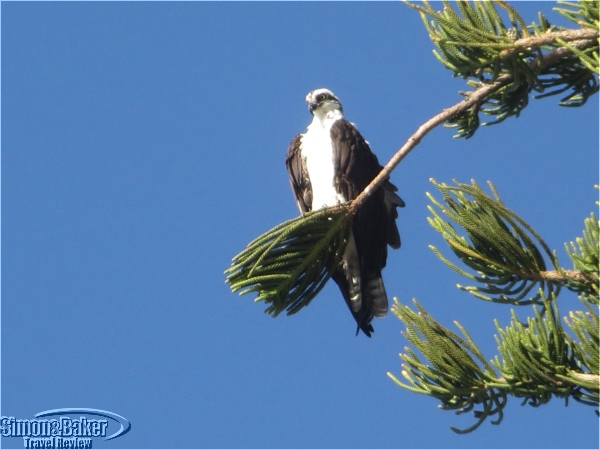
An osprey caught our attention while we were walking on the beach
Although we walked the length of the beach from north to south and south to north, we spent the majority of our time in the north end of Holmes Beach and the City of Anna Maria. Both were more residential than commercial as well as quieter and less crowded, by comparison, than the south end of Holmes Beach and Bradenton Beach. Visitors and residents made their way around the island on foot for short distances. Cars, golf carts and a complimentary trolley (a full size air conditioned bus when we were there) with frequent stops over most of the island shared the few roads. A favorite option was to ride the trolley to the end of the line on the southern tip of Anna Maria Island, and walk along the beach all the way north or to our beachfront rental. We also walked south and returned via the trolley, but it meant facing the hot sun for most of the walk south so we preferred riding the trolley south and walking north.
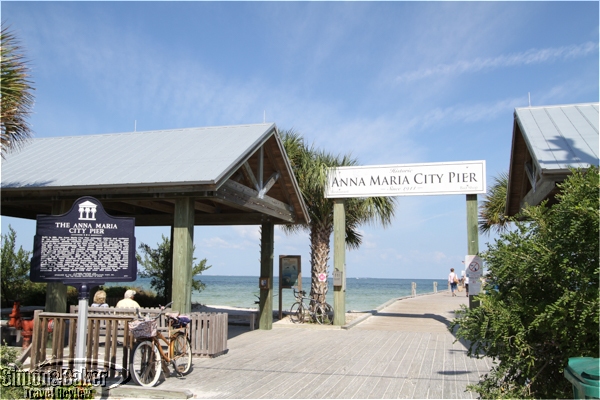
The Anna Maria City Pier was popular
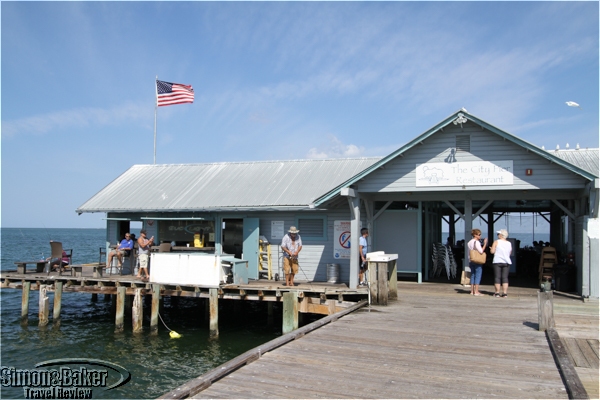
The Anna Maria City Pier Restaurant surrounded by people fishing
In the City of Anna Maria, we liked Pine Avenue for window shopping. The Anna Maria City Pier, on the east end of Pine Avenue, was fun of people watching and strolling. From the pier we could see the mainland in the east. And below the surface the water was so clear we could see fish and pale sand at the bottom. At the end of the pier, people with a variety of regional accents, some speaking European languages, fished contently. We especially appreciated that the entire city was a bird sanctuary.
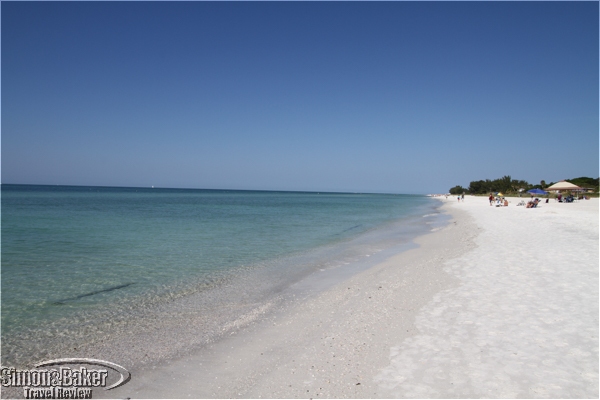
The water was clear and inviting
For a sweet treat there was Hometown Desserts (507B Pine Avenue, Anna Maria, Florida 34209, +1 941 896-3167), a tiny shop off Pine Avenue, the main road, where I bought cookies, key lime pie, cup cakes and coconut macaroons (a gluten free option). For an alfresco lunch we liked The Waterfront Restaurant and Craft Bar (111 South Bay Boulevard, Anna Maria, Florida 34216, +1 941-778-1515, https://thewaterfrontrestaurant.net/, info@thewaterfrontrestaurant.net), across the street and half a block south from the pier. It offered friendly service and seating indoors and on a shady outdoor deck facing the bay. It was popular on weekends. We had to wait an hour Friday afternoon for a table on the covered terrace.

The local grocery and deli on Pine Avenue in the City of Anna Maria
In general, the firm white powdery beach was our favorite feature on the island. In the predawn hours and as the sun was rising many people walked and jogged along the shore. Despite the wide beach it felt crowded at times yet it was pleasant and surprisingly clean. As the sun advanced in the sky more beach lovers arrived with chairs, umbrellas and snacks to settle in for a several hours. Few went in the clear chilly water. Some collected seashells or made sandcastles. Later as the sun waned a batch of sun lovers made their way to the seashore to catch a glimpse of the sunset. Waiting for the golden orb to dip beyond the horizon became one of our daily treats.
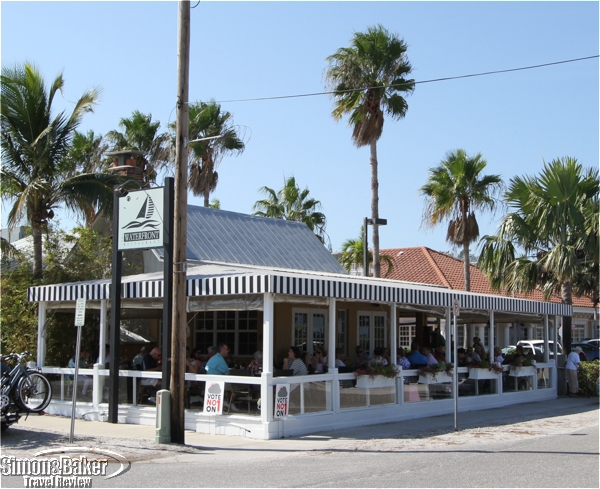
The Waterfront Restaurant and Craft Bar was a favorite for alfresco dining
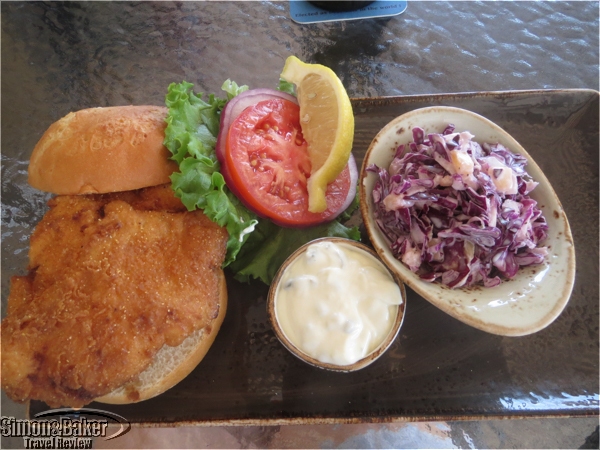
The grouper sandwich
Our stay on Anna Maria Island was pleasant and worth repeating. I would return to the City of Anna Maria and Holmes Beach for its pretty white sand beach, relaxed resort style ambiance, upscale accommodations and natural setting.
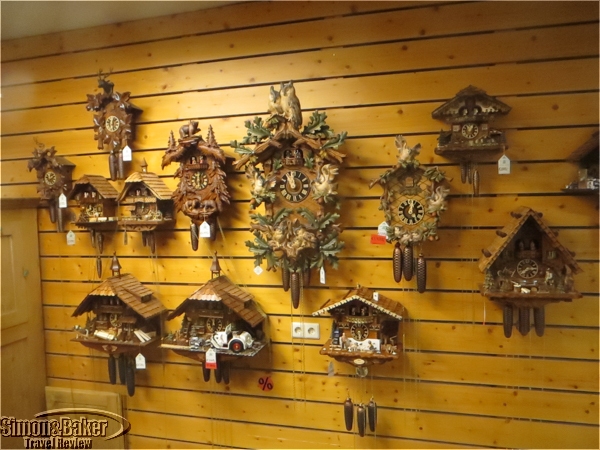
by Editor | May 15, 2017 | Accomodations, Attractions, Luxury Travel, Restaurants, Spas
By Elena del Valle
Photos by Gary Cox
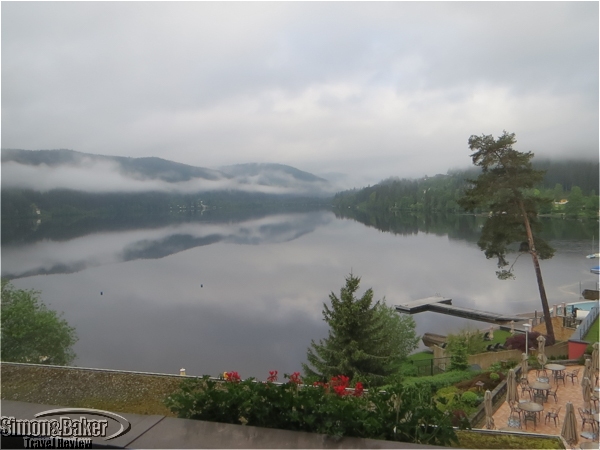
A typical dreary day by Lake Titisee during our visit
We planned our week long trip to the Black Forest Highlands in Germany months in advance with the expectation that a spring itinerary would reward us with dry and sunny weather. Instead it our visit in June 2016 was far wetter, colder and foggier than we had anticipated. It rained on and off most of the day every day during our whole stay in the area, forcing us to revise our plans entirely. In lieu of trekking on mountain tops and cable cars we spent our days in our hotel room waiting for the rain to stop or remained indoors, dining, in museums, and churches for the duration of our visit.

The clock museum featured displays of clock history
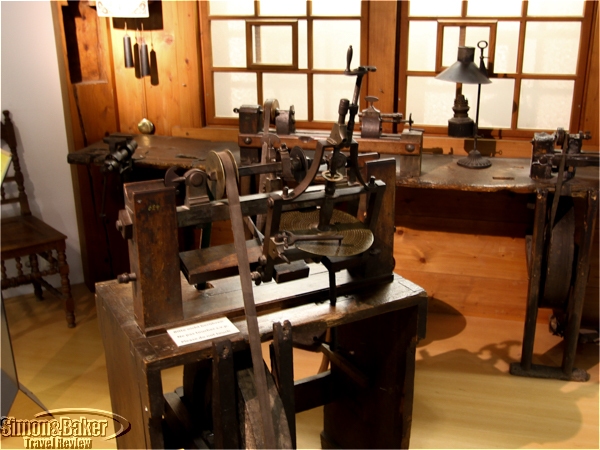
Tools used to automate the creation of the gears and wheels were featured
We replaced nearly all our outdoor activities with indoor ones. The two lane mountain roads, slick from the rain and filled with impatient drivers, did nothing to improve the situation. In the end, we made the most of the situation, exploring as best as possible in moments of respite from the constant showers. We seldom encountered English speakers or materials in English, making it necessary for us to rely on our guide frequently to translate menus at restaurants and information sheets at attractions.
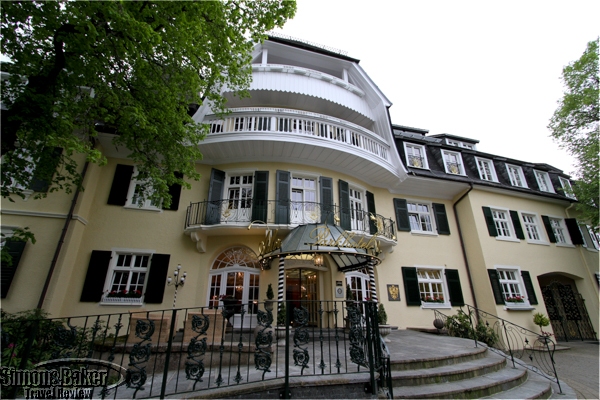
The Parkhotel Adler in Hinterzarten was a favorite for its luxury facilities and spa
From the airport we drove to the Parkhotel Adler in Hinterzarten. It was the most luxurious of the properties we visited that trip. I spent time at Hoffmann Beaute & Physiontherapie, its serene spa. Because of the cool temperatures and showers I was thankful for the property’s underground hallways that connected its facilities and provided us indoor access to the hotel spa and restaurants in adjacent buildings.
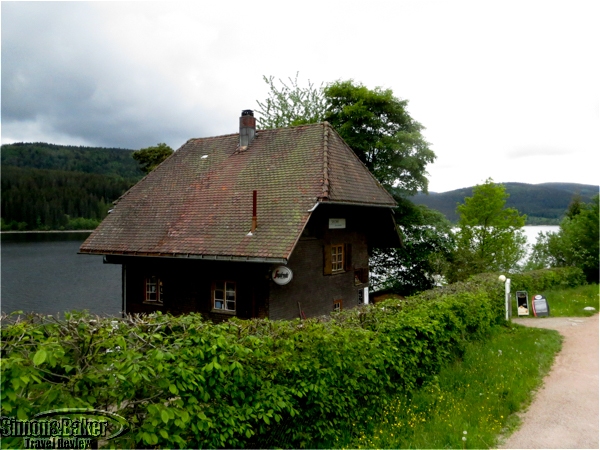
The lake fronting Seecafé in Schluchsee
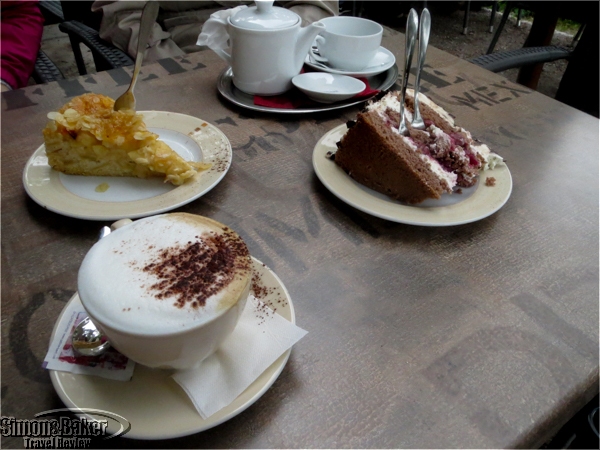
We had Black Forest cake, strudel cake and cappuccino by the lake
The first attraction we visited was the Deutsches Uhrenmuseum (German Clock Museum at Robert-Gerwig-Platz d-78120 Furtwangen, +49 7723-920 2800, deutsches-uhrenmuseum.de) northeast of Freiburg. It was a fun way to spend the morning and learn about the history of clock making in Germany.
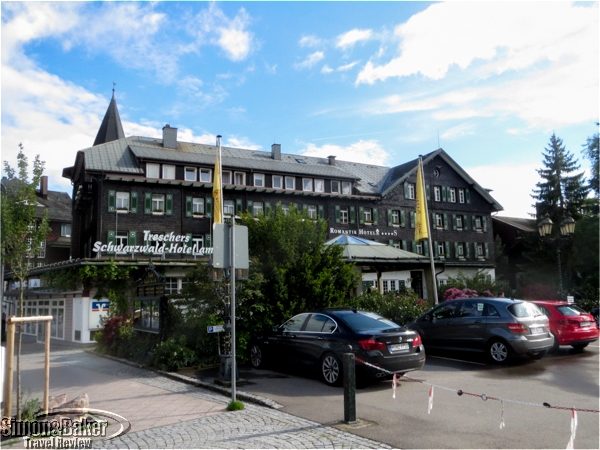
We spent the weekend at the popular Treschers Schwarzwald Romantic Hotel
One afternoon, to satisfy our sweet tooth we stopped at the Seecafé (Im Wolfsgrund 26, 79859, Schluchsee, +49 76 56/98 88 97), where we indulged in hot beverages and huge slices of regional specialties such as Black Forest chocolate cake. Despite the chilly temperatures we enjoyed the Schluchsee lakeside setting and terrace seating until a steady flow of raindrops forced us to leave.

We were delighted with our first sunny hour from the patio at Boutique-Hotel Alemannenhof
In the Lake Titisee area we stayed at two family owned properties. We spent the weekend at the popular, lake fronting Treschers Schwarzwald Romantic Hotel (see Our weekend stay at Black Forest lake front hotel with spa) with a spa in the highly touristy town of Titisee. When our rental apartment plans fell through the friendly owners and staff at the charming and lovingly built Boutique-Hotel Alemannenhof squeezed us in at the last minute without hesitation. The hotel, the Drubba Monument Shopping stores on the pedestrian street in Titisee, and the Hofgut Sternen hotel and adjacent shops were the property of the enterprising Drubba Family. It was at one of their shops where we watched a demonstration about the making of the famous cuckoo clocks. At another we caught the end of a glassblowing demonstration. Their hillside property was a favorite for its Lake Titisee views and foodie orientation.
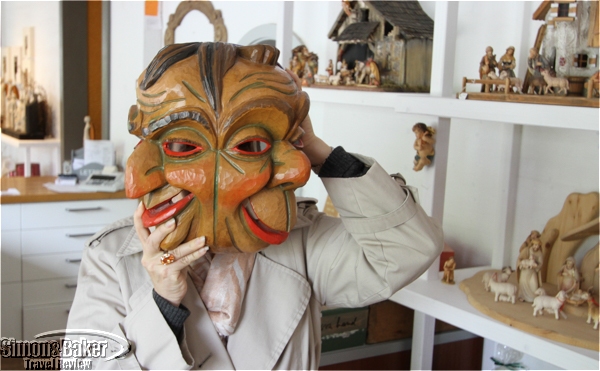
One of the hand-carved carnival masks at Holzmasken Stiegeler in Grafenhausen
In Grafenhausen, we liked the hand-carved carnival masks at Holzmasken Stiegeler (see Black Forest shop carried on with wood carved mask tradition). In Grafenhausen-Rothaus, we visited Hüsli or small house (79865 Grafenhausen-Rothaus, Am Hüsli 1 im Naturpark Südschwarzwald, + 49 77 48/212, www.hüsli-museum.de), a folk art museum dating back to 1912 when actress Helene Siegfried built a summer home from second-hand materials. We also toured the Rothaus (Badische Staatsbrauerei Rothaus AG, Rothaus 1, 79865 Grafenhausen-Rothaus, +49 7748/522-0, www.rothaus.de, info@rothaus.de) brewery museum, a modern facility with self-guided tours, where we sampled locally produced beer and bought souvenirs at the small shop.

St. Blasien Cathedral, a lovingly maintained structure 36 meters wide and 62 meters high
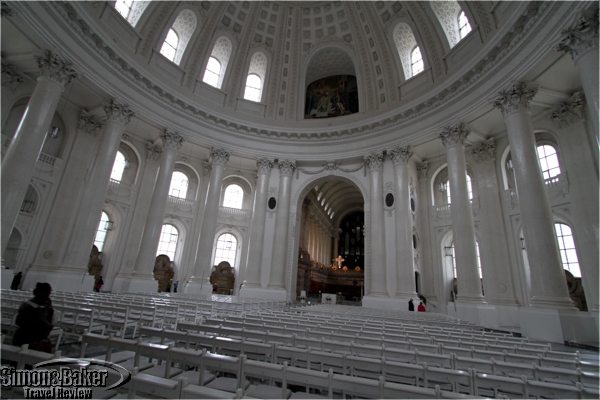
The interior of St. Blasien Cathedral

The St. Blasien Cathedral cupola
We visited several churches while in the Black Forest Highlands. Salient among them for sheer size and the determination of its builders was St. Blasien Cathedral, a pretty and lovingly maintained structure 36 meters wide and 62 meters high. The early classical cupola is the largest of its kind north of the Alps.
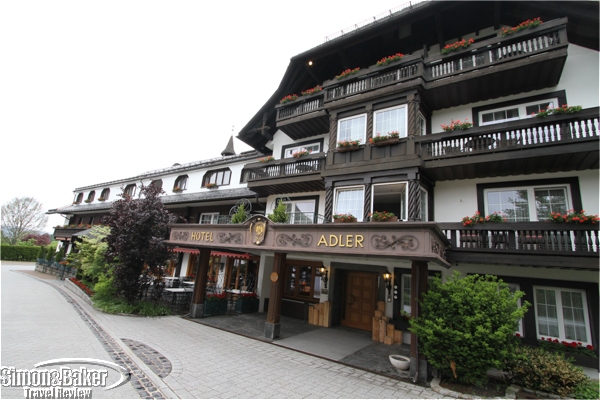
Our final nights were at the Hotel Adler in Häusern
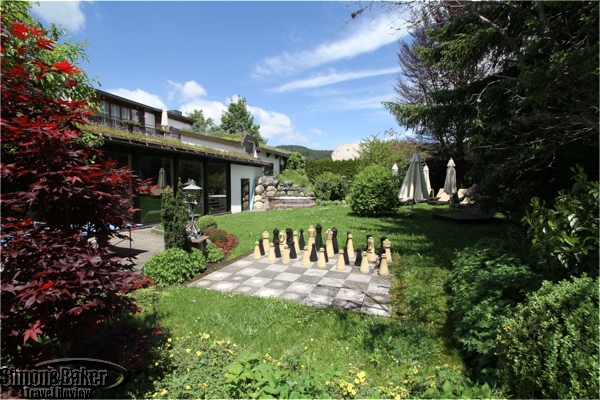
The sun made an appearance on our last afternoon in the Black Forest
Our final nights were at the Hotel Adler in Häusern, where we dined at the hotel’s gourmet restaurant (see Dinner at Black Forest Highlands gourmet restaurant). We would recommend the Black Forest Highlands to friends who speak German or don’t mind seeking translations, like moderate luxury in a heavily touristy area with authentic regional cuisine, enjoy mountainous landscapes and the outdoors, and are able to change plans in a hurry if the weather turns ugly.
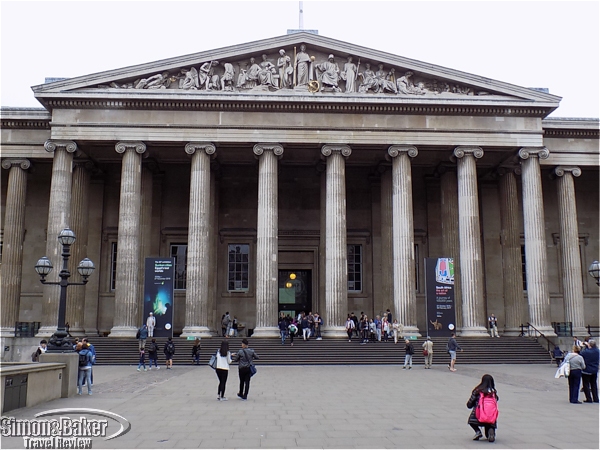
by Editor | May 1, 2017 | Attractions, Luxury Travel
Article and photos by Scott S. Smith

London’s vast British Museum is the oldest public museum in the world
My wife and I thought we could run through a refresher on London’s British Museum when we visited for the second time in September 2016 (Great Russell Street, +44 020 7323 8000, www.britishmuseum.org, info@britishmuseum.org). We had taken a full two days 35 years before when we were last there, but figured four hours would be enough to hit the highlights. Relying on the invaluable DK Eyewitness Travel Guides London, with additional tips from Rick Steves’ Pocket London and checking the website, we boiled down the list to just the must-see-agains and some we had overlooked or which had not been on display (we belatedly discovered that only one percent of its 50,000 items are exhibited at any one time). Despite the name, this is really the greatest museum in the world on the history of the ancient world, thanks to plundering by colonial officials who had the classical education to appreciate what they brought back. As if that weren’t enough, it also has artifacts up to the present day. Established in 1753 to house a private collection, the main current building was completed in 1850, and the entire complex of 94 galleries on three levels occupies a total of 2.5 miles. We recommend to our friends visiting for the first time that they take one of the highlight tours and set aside at least one full day for the museum. To avoid crowds, we will visit weekday afternoons.

A 19th century priestly mask from the Songye people in the Democratic Republic of the Congo
We found the lower floor (basement) of the British Museum was overlooked because it is primarily devoted to Africa, while the other two floors had many world-class treasures. But African art has always been a favorite of ours when we go to any major museum of world culture. The African imagination has always struck us as astonishing, perhaps unleashed by its magical view of reality. The ritual masks, costumes, and statues are always better than anything we’ve ever seen near our home in West Hollywood, California, at the Halloween street parade, which is saying something (it draws half a million participants and spectators due to the creative contributions from movie professionals). This time, we particularly liked a multi-horned headdress for ancestral ceremonies from 19th century Nigeria and some famous bronze statues from the Kingdom of Benin.
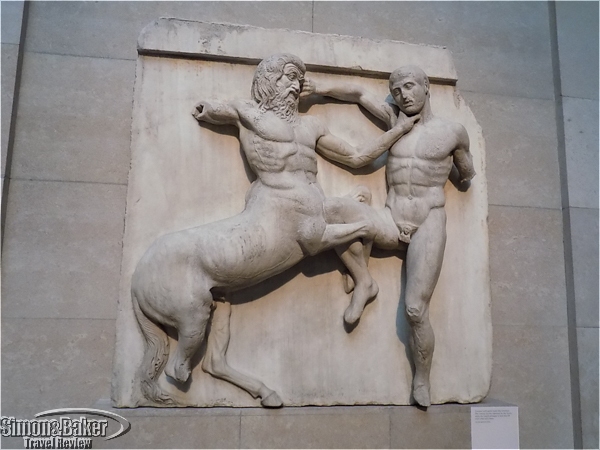
A Centaur and Lapith wrestle in a relief from the Parthenon
Back on the ground floor, we headed straight to the enormous room displaying the Elgin Marbles, décor from the Parthenon, the temple of Athena on the Acropolis in Athens, which the British brought back in 1816 and the Greeks have been trying ever since to get returned. Despite thousands of years of wear from exposure, they still showed the brilliant skills of the sculptors during the Golden Age of Greece (500-430 B.C.), the cultural supernova that led to the Renaissance and Western civilization (the best summary of their contribution is Edith Hamilton’s The Greek Way). We also saw many other gorgeous sculptures and ceramics from the Greeks and Romans in other galleries and on the upper floor.
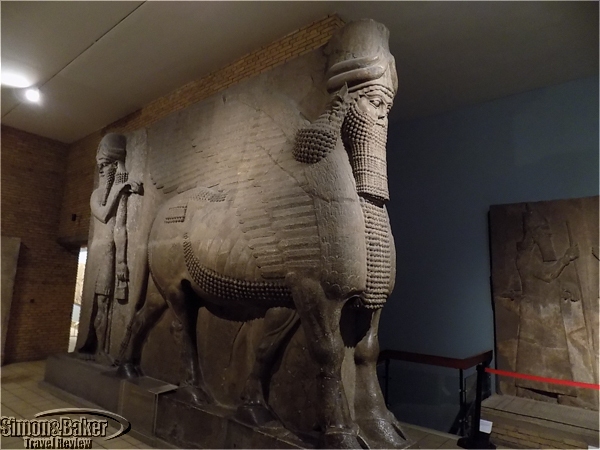
Human-headed winged bulls from the Palace of Sargon II at Khorsabad, Assyria (near Mosul, Iraq)
The ground floor also had much from the ancient Middle East, especially Assyria. There were several sets of enormous winged-bulls that guarded the palaces of Sargon II, who reigned 721-705 B.C. and according to the Bible took the northern 10 tribes of Israel into captivity (now referred to as the Ten Lost Tribes, they were said to have “gone north” after Assyria’s fall, but may have simply blended in with other peoples in the region). One famous relief depicted the royal sport of lion hunting, and there were artifacts from ancient Jericho and Islamic cultures. More from the Middle East, especially Iran, was on the upper floors, but we just breezed through it for lack of time. The collection for the Americas was confined to two modest rooms, but had some outstanding sculptures from ancient Meso-American peoples, such as the Zapotecs. As for the rest of the floor, having been to India and Japan, and having little interest in China, we skipped the Asian section.
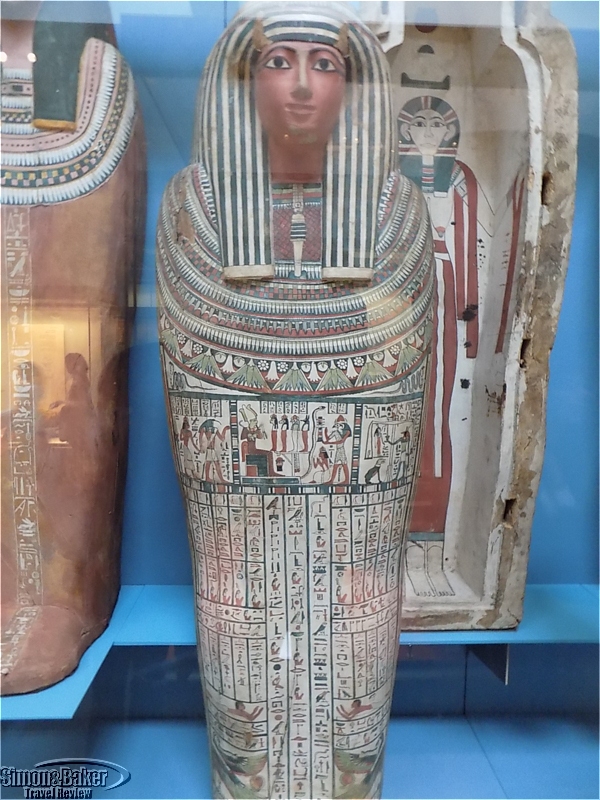
Coffin of Egyptian incense bearer Denytenanum, Temple of Amun, Thebes (9th century B.C.)
The upper floor’s Egyptian section may be the world’s best outside of the Cairo Museum (which we’ve been to). It is world famous for having the Rosetta Stone, carved into which was a trilingual inscription that enabled the French to begin to decipher the hieroglyphics. It was hard to photograph through the glass and the writing is tiny, but there was a model nearby we could touch. Another outstanding item was the enormous statue of Ramesses II, the 13th century pharaoh many believe was the one who reluctantly let the Israelite slaves leave Egypt. There were also numerous mummies and painted coffins.

Zapotec funerary urn from Mexico from about 200 B.C.
The other primary section on the upper level we were interested in was for Britain, covering as far back as 10,000 B.C. The most striking item was the 2,000-year-old Lindow Man, who was sacrificed in a ritual way, his skin preserved in a peat bog in Cheshire. The other big draw was the burial of a 7th century A.D. Anglo-Saxon king in a ship filled with treasures at Sutton Hoo, East Anglia, discovered in 1936. Among the many notable items, which revolutionized understanding of the era, were a ceremonial helmet, a shield, gold jewelry, silver bowls, and a lyre, a harp-like instrument. Now that we have been reminded of how incredible the British Museum is, we will not take another 35 years to return and will give it the time it needs to be fully appreciated in the future. There is a reason it is the top tourist destination in Britain.

by Editor | Apr 17, 2017 | Attractions, Luxury Travel
By Elena del Valle
Photos by Gary Cox

A display of masks at the shop entrance included a mythological figure with antlers.
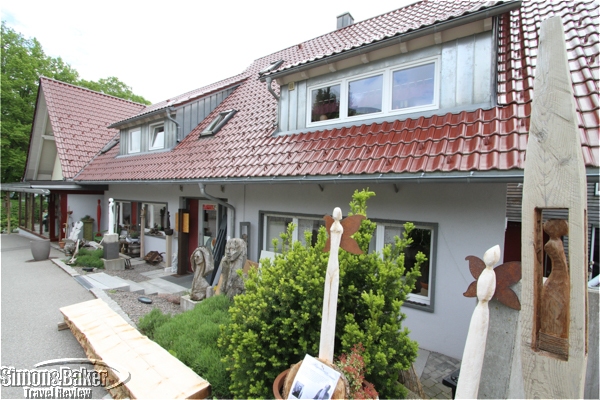
There were large sculptures outside the shop.
As a child Simon Stiegeler watched his parents carve traditional wood masks in their workshop in the Black Forest Highlands of Germany. As he grew older, he learned the craft in a woodcarving school in Austria and studied art in Freiburg. In time he adopted the family tradition. These days he spends his time at the Holzbildhauerei Stiegeler (Kirchsteig 5 79865, Grafenhausen, Black Forest Germany, + 49 07748-283, www.holzbildhauerei-stiegeler.de, www.holzmasken-stiegeler.de), a 100 square meter shop and workshop he owns with his family.
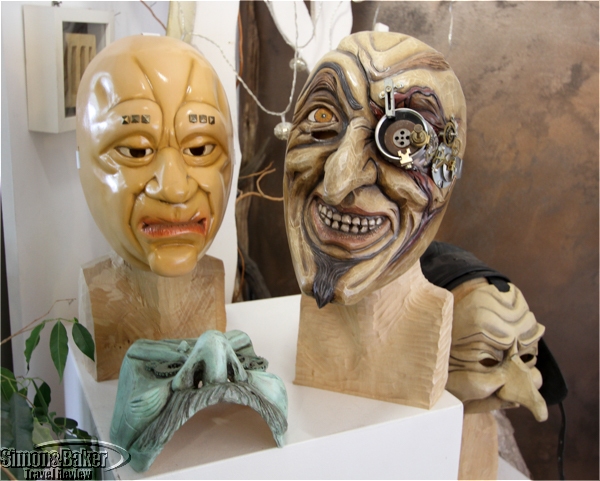
The masks varied from traditional designs of the region to modern adaptations.
That was where we met him, making schwäbisch alemannische fasnacht masks out of linden wood. There were witches, devils, animals, jesters and fools, some known by their local names from old words such as holzmaske, schemme, and larve. One of my favorite masks had a science fiction theme. Prices ranged from 50 to 1,200 euros.

The artist at work
“The black forest has an very old tradition in making wood masks, times ago many farmers made wood masks in the long and cold wintertime,” he said when asked about the origin of his business. “I think we are one of the last profesionell (professional) family business whitch (which) exclusively make wooden masks.”
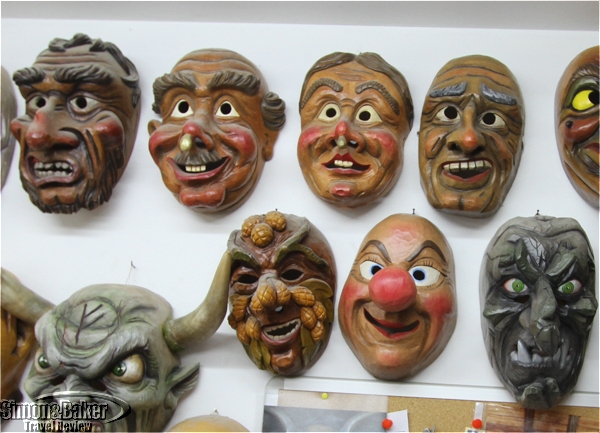
A variety of masks hung on the walls of the workshop.
He mainly makes masks for groups, collectors, actors and special orders, he explained during our visit. In 2010, he was invited to the World Expo in Shanghai, China to present the masks as a culture ambassador for Germany.
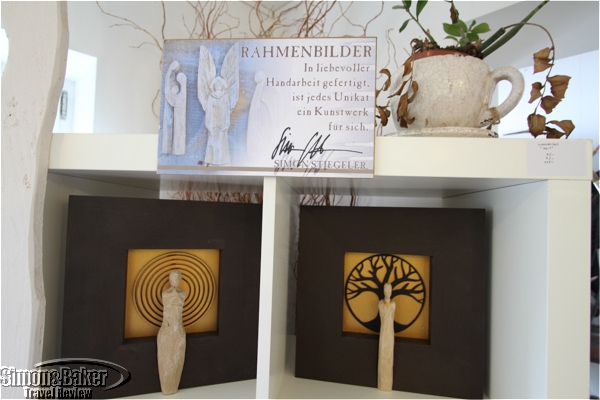
There were other wooden items in the shop.
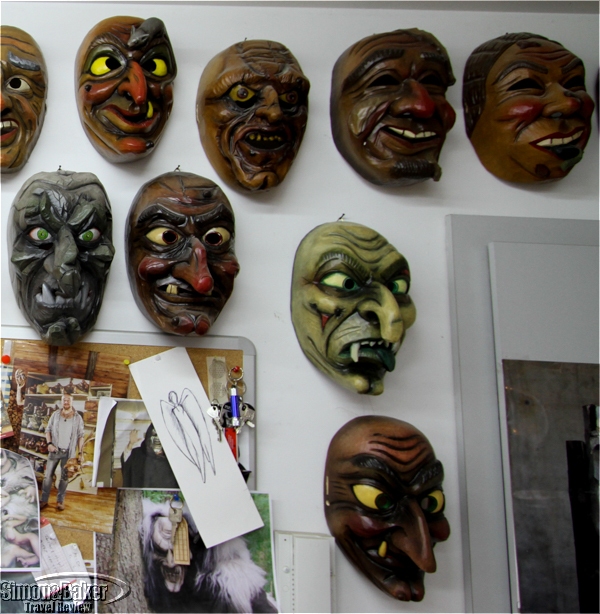
The artist makes masks for groups, collectors, actors and special orders.
Custom masks usually require three days, he explained. During that time he carves the mask by hand and his wife, Lillian Stiegeler, paints it. In his shop there were also modern wood carved souvenirs, especially wooden angels called flügelwesen, as well as Blackest-Forest, a house line of Black Forest themed souvenirs.
































































